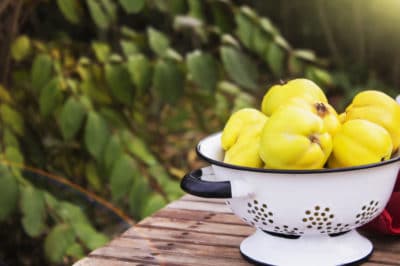Identifying a Ripe Quince
Spotting a ripe quince is as simple as spotting an unripe one: the ripe one will be golden yellow, with nearly all of its downy webbing missing. It will also twist easily off the tree. But — if all else fails — your nose will know. Ripe quinces have an intensely haunting, floral-citrus-pineapple fragrance unique in the plant kingdom.
Yellow quinces still tinged with lime green will ripen within a few days, on or off the tree. The dark–green, downy ones will rot after picking.
Expert gardener’s tip: Once a quince reaches the solid-yellow stage, you might as well harvest it. Otherwise, the first stiff breeze will knock it off the tree.
When Is Quince Season?
Quince trees (Cydonia oblonga) grow in a wide range of climates. In the United States, they’re suitable for planting in USDA hardiness zones 4 through 9. In the growing conditions of California’s San Joaquin Valley, they begin ripening in early August. In Chile, they’re harvested from March through May.
The commercial California harvest ends in early November. But, in the cooler parts of their range, quinces may not ripen until late October, with the harvest continuing until late November.
Expert gardener’s tip: Many quince connoisseurs believe quince trees grown in warm-summer climates produce the sweetest, softest fruit. In colder areas, espaliering them against a south- or west-facing wall may achieve the same results.
Quince Cultivar Ripening Times
The ripening times for some widely available quince cultivars:
- ‘Van Deman,’ hardy in zones 4 though 9, has spicy-sweet, pear-shaped fruit ripening in September.
- ‘Karp’s Sweet’ grows in zones 5 through 9. Its black-speckled fruit (resembling ‘Golden Delicious’ apples) ripens in September and October.
- ‘Seker Gevrek,’ a Turkish cultivar hardy in zones 5 through 9, is notable for crispy, sweeter-than-normal fruit that ripens in early October and stores well until February.
Cooking Ripe Quince
Ripening doesn’t do much to make most quince fruit palatable, because of the extremely bitter, protein-binding chemicals it contains. Only long cooking at low heat makes it sweet and soft enough to eat.
In the process, the pulp’s color changes from pale green, orange or white to ruby-red. Simmered long enough, the high-pectin pulp becomes a rich, flavorful paste known in Spanish-speaking cultures as “membrillo.” It’s served as an accompaniment to fresh cheese.
